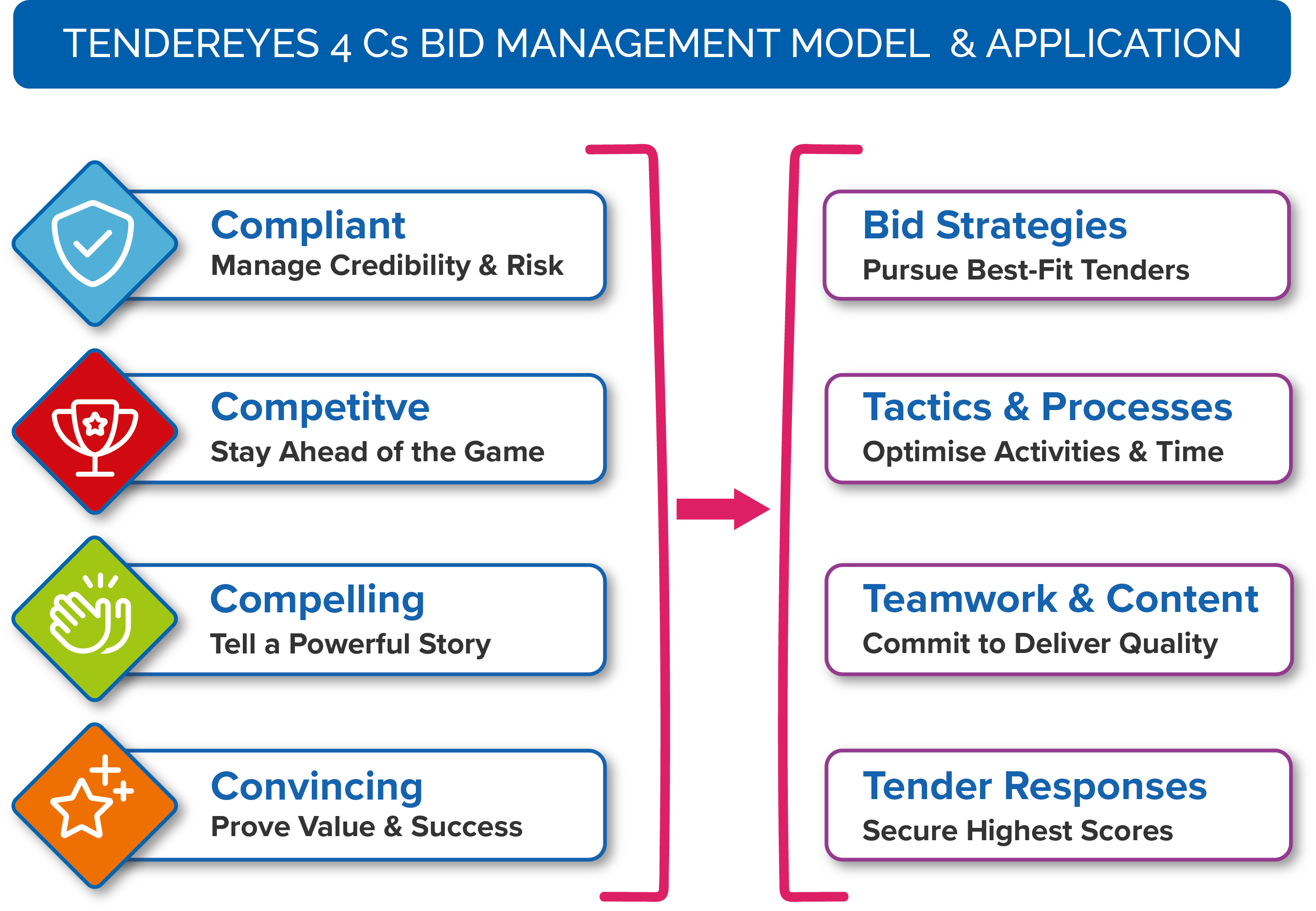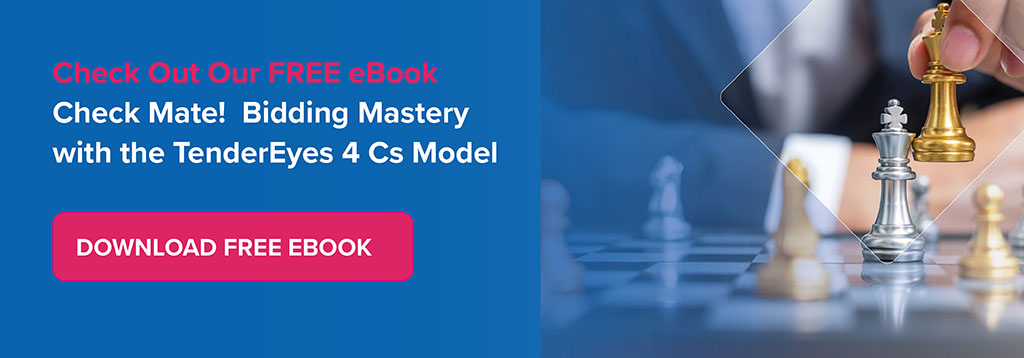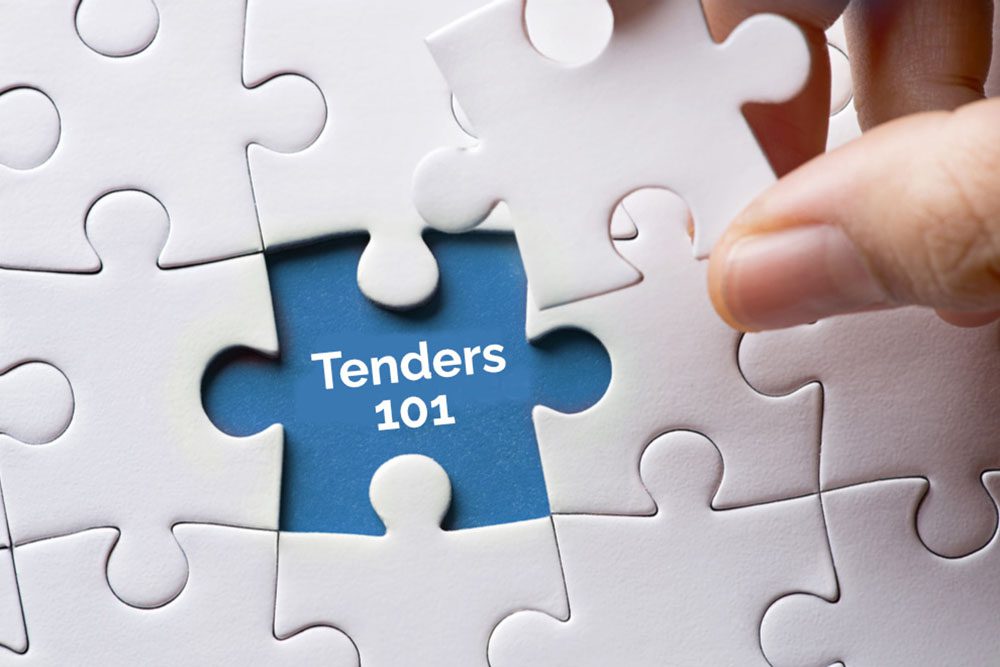Mastering the ability to consistently compile tender responses that secure the highest evaluation scores and win the contract is the aim of the game! But it’s a big challenge to achieve in highly competitive markets and tight timescales, especially when dealing with 100s of questions.
In this article we introduce the TenderEyes 4Cs Model as a practical and effective framework for compiling high quality tender content and submissions. We will consider the challenges faced by bid teams and the benefits of using the TenderEyes model to shape bid tactics, decisions and tender responses.
Plus we provide an example question and answers built on the elements of the 4 Cs model, taking the responses from a 60% to a potential 95% evaluation score.
Introducing the TenderEyes 4Cs Model
We previously introduced the 4 Cs model in an article published in November 2023, which focused on its application to help shape bid strategies. Plus the 3rd blog in this series where we demonstrate how to use the 4 Cs Model within the TenderEyes software.
The TenderEyes 4 Cs model has been designed to apply to both strategic and tactical decisions as well as the whole bid journey from sourcing and qualifying tender opportunities to compiling and submitting bids and delivering won contracts. The model can also be applied to performance analysis and improvement plans.
Now let’s take a deeper look at how to apply the 4 Cs Model to compile bids and tender responses. We consider the client requirements, partners, and supply chain as well as the tender submissions themselves.

1. Compliant: The Foundation of Trust
Compliance is the bedrock upon which successful tender submissions are generated.
With huge investment in resources and time to generate bids, ensuring adherence to the procuring agency’s stipulated requirements, regulations, and guidelines is critical. This will ensure your business is not unnecessarily discounted before, or poorly scored during the procuring agencies evaluation stage of the tender process.
Your tender submission is also one of the most commercially sensitive documents you will publish outside of your business. So ensuing compliance with your internal business policies, governance, objectives, and goals will be essential to mitigate any reputation or financial risks.
- Client Focus: A comprehensive understanding of the tender documentation, coupled with meticulous attention to detail and compliant tender responses will help establish your organisation as a reliable and responsible supplier, as well as possibly securing you higher evaluation scores.
- Partners & Supply Chain Focus: Partners and sub-contractors may potentially play a pivotal role in delivering your won contracts. It is therefore essential to ensure they are aligned to your business values, governance, needs and goals.Early engagement and open discussion on tender requirements will be essential to ensure you pick the right partners for the job. Signing of partnership agreements will secure partner and subcontractor commitments and internal approvals.Demonstrating partnership alignment and commitment within your tender submission will highlight your professionalism and attention to detail. This will provide a level of confidence and trust from the procuring agency that you can successfully deliver the contract.
- Tender Submission: Ensuring your tender responses answer any questions or parts of questions on compliance issues will be critical to secure base level evaluation scores. Inability to meet or detail such requirements may seriously impact your win probability.In addition, ensuring compliance in the process and mechanics of submitting a tender is also critical. Certainly, you don’t want all your efforts to be wasted through a careless submission practice. Ensure you have:
-
- Answered all questions and supplied appendices
- Used the correct branding, grammar and spelling
- Supplied correct pricing spreadsheet and financial evidence
- Secured proper approval and sign-of
- Submitted on time, to the right portal and in the right format
- Accepted Terms & Conditions
- Answered any post submission clarification questions.
2. Competitive: Gaining Market Advantage
Competitiveness is the driving force behind your bid activities.
Undertaking rigorous market analysis, having a keen understanding of competitor strengths and weaknesses, a strong value proposition and pricing strategy are key components of a competitive tender strategy.
By positioning your offering within your tender submission, as the most advantageous in the market, you increase the likelihood of standing out among competitors and securing the coveted contract.
- Client Focus: It is important to show differentiation between you and competitors throughout your tender submission. This may include advantages in market position, company values and goals, R&D, HR & CRS, products, pricing, service delivery etc. Each competitive angle could secure you additional evaluation points and culminate in you winning the contract.
- Partners & Supply Chain Focus: It is also essential to be competitive when considering and securing partners and sub-contractors. Being able to demonstrate you have unique networks and longstanding relationships with market leaders and experts in their field will help differentiate you from your competitors. This will provide the procuring agency with confidence that you have a good and able delivery team in place.
- Tender Submission: There will be questions that can more easily be responded to with a competitive answer such as product or service related questions. However, it’s also advantageous to consider how you can bring a competitive element into other questions such CRS, HR or financial related questions. Competitor differentiation and advantage can take the form of:
-
- Unique selling points
- Direct and indirect benefits
- Mitigation for competitor differentiation & discrimination.
3. Compelling: Crafting a Narrative that Resonates
A compelling tender proposal goes beyond meeting the basic requirements; it tells a story that resonates with the needs and aspirations of the procuring agency.
This involves aligning your organisation’s strengths with the specific challenges outlined in the tender documentation. A well-crafted narrative not only demonstrates your understanding of the project but also highlights the unique value proposition that sets your organisation apart.
- Client Focus: Your aim here is for the procuring agency to buy into ‘the dream’. To generate excitement and buzz that your business is bidding for their contract. To demonstrate within your submission:
-
- A positive perception of your business
- Shared corporate values
- Minimalised risks.
- Partners & Supply Chain Focus: Choosing partners and subcontractors with strong brand reputations and similar values and behaviours is crucial. This alignment with both the procuring agency and your own business cultures will provide an additional level of comfort in the collaboration.
- Tender Submission: This is where skills with the written language are essential. The above 2 elements of compliance and competitiveness can be portrayed in very factual ways. Now it’s time to start finessing your tender responses and adding more compelling detail, even for the more mundane questions! Consider how you will:
-
- Sell the dream
- Get creative with responses
- Make it interesting to read
- Use factual and emotive language and storytelling.
4. Convincing: Building a Persuasive Case for Selection
Conviction is the final frontier in the 4 Cs model. Your tender submission must not only meet the criteria but also convince the procuring agency that your organisation is the ideal choice.
This involves presenting a robust case, supported by evidence and a clear roadmap for project execution. A convincing tender is one that instils confidence, assuring the procuring agency that selecting your organisation is a decision they won’t regret.
- Client Focus: You will need to convince the client through clear articulation and supporting evidence that you can deliver the project on time and in budget. And better than anyone else! The stronger the case you can put forward the more confidence the procuring agency will have in awarding you the business.
- Partners & Supply Chain Focus: Undertaking due diligence is essential when securing agreements with partners and sub-contractors. This needs to include requesting evidence of prior collaborations and delivery successes, as well as their own customer case studies, testimonials and references. These documents can also provide an additional level of conviction within your tender submissions. Giving the procuring agency further confidence in contract delivery success.
- Tender Submission: This is a critical element of your tender submission and requires forward planning and generation of documentation and customer engagement. Having a comprehensive Bid Library or Knowledge Bank with such materials already in place, will provide a huge advantage. You certainly don’t want to be wasting time scrambling around trying to find or create the following evidence:
-
- Insurances, HR and CSR Polices
- Performance and financial records
- Employee testimonials e.g. Glassdoor
- Customer case studies and satisfaction results
- Well-matched references that are set up to take calls.
Benefits of Adopting the TenderEyes 4 Cs Model for Tender Responses
As you can see using the TenderEyes 4 Cs Model allows you to take each question within a tender and optimise the content of your responses.
Ensuring all members of your Bid Team, Subject Matter Experts and Approvers are conversant with this framework provides a powerful tool to delivering consistent quality tender responses and supporting evidence.
This will help you secure higher evaluation scores across the whole tender and place you in a much stronger position to win the contract!







